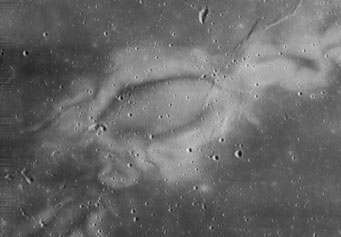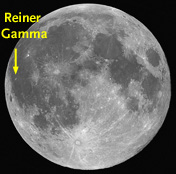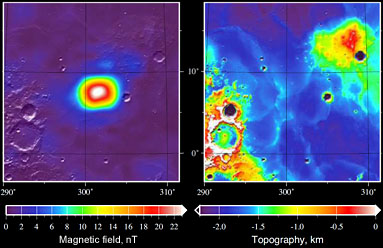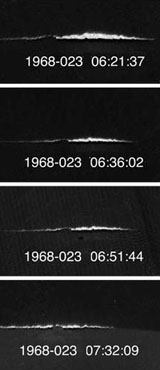You'll have to stay up late to see it, but this week's waning gibbous Moon affords a great opportunity to eyeball one of the most curious features anywhere on the Moon. It's Reiner Gamma, a bright, conspicuous smudge near the equatorial limb along the margin of Oceanus Procellarum.

The mysterious lunar swirl Reiner Gamma is about 20 miles (35 km) across. This view was captured by Lunar Orbiter 4 in 1967. A seldom-seen oblique perspective is here.
NASA
Reiner Gamma is the best-known example of a group of lunar swirls that have baffled planetary geologists for decades. (A terrific one on the Moon's farside is Mare Ingenii.) These peculiar patterns look a little like crater rays, but they're curvy and lack source craters.
In fact, there's nothing obviously geological about them. "Swirls remain one of those big unanswered questions in lunar science," admits Catherine Neish (Applied Physics Laboratory).

Located at 59° west, 8° north, Reiner Gamma is easily observed with a telescope.
Gary Seronik
It's long been speculated that these oddities are somehow related to variations in the "space weathering" of the lunar surface. The gritty dust lying on top darkens over time due to exposure to radiation (solar wind, cosmic rays) and to micrometeoritic bombardment. This creates dark microscopic beads of iron in the rocky minerals. That's why rays from a fresh crater look bright against the older terrain they land on.
The mystery only deepened when orbiting Apollo spacecraft (and later Lunar Prospector) found strong magnetic fields directly over the swirls — surely an important clue. Back in 1989, Lon Hood and C. R. Williams (University of Arizona) plausibly suggested that the patchy, localized magnetic fields are shunting solar-wind plasma away from the swirls' bright areas and funneling it to the dark lanes that snake through the features.
Others have proposed that the swirls arose from impacting comets: maybe turbulent gas in their comas scoured the surface and exposed fresh (bright) dust. But if that's the case, then comet strikes throughout solar-system history should have tattooed the entire lunar surface with swirls, not just here and there. Or perhaps the cometary gas shock-heated and magnetized the surface. But calculations suggest a thin surface layer can't become magnetized strongly enough to create the observed anomalies. "I don't think Reiner Gamma looks like a comet impact," argues Georgiana Kramer (Lunar & Planetary Institute).

Recent observations being brought to bear on Reiner Gamma include scans by a magnetometer aboard Lunar Prospector (left) and topographic mapping by a laser altimeter aboard Lunar Reconnaissance Orbiter (right).
NASA / Mark Wieczorek
Fortunately, recent missions to the Moon — particularly NASA's Lunar Reconnaissance Orbiter (LRO), India's Chandrayaan 1, and Japan's Kaguya — have amassed a formidable arsenal of new observations, and a score of specialists gathered at the just-ended Lunar and Planetary Science Conference to plan their analytical attack.
So far, the new data are saying a lot about what lunar swirls aren't. For example, tedious crater-counting by Kramer and others argues that the Mare Ingenii and other swirls are not freshly exposed surfaces. LRO's laser altimeter shows that they're not lumpy or elevated; radar scans haven't turned up any differences in surface roughness, and infrared maps made during the long lunar night reveal no thermal anomalies.
One promising idea, put forward at last year's meeting by Ian Garrick-Bethell and two colleagues at Brown university, avoids the pitfalls of selective space weathering and instead envisions a way to continually brighten the swirls with a continually replenished topping of very fine dust.

A series of television images relayed to Earth in January 1968 by the lunar lander Surveyor 7 show a line of light along its western horizon after sunset — the result of fine dust particles suspended above the surface. Surveyors 5 and 6 witnessed the same phenomenon.
NASA / NSSDC
Their view is based on the unexpected revelation that microscopic particles become statically charged and levitated above the lunar surface, particularly at times near local sunrise and sunset. (No one knows why this happens, but it does.)
Once lofted, these ultrafine particles can be moved around by electric fields created within the localized magnetic bubbles, lateral shuffling that removes dust in some places and deposits it in others. The dusty topcoat would have to be at least a foot thick, based on calculations just published in Icarus. But they can't be thicker than about 30 feet (10 m), notes Garrick-Bethell, because the swirls' bright lanes show no vertical relief in low-Sun-angle images.
In time, the new infusion of composition and reflectivity measurements might finally determine the true nature of these delicate, enigmatic features, though Garrick-Bethell cautions, "Ultimately, we really need some measurements of the plasma and dust environment near the surface."
How and when the magnetic anomalies arose is yet another mystery. One idea, proposed at the meeting by Mark Wieczorek (Institute of Earth Physics of Paris), posits that they're linked to blobs of molten debris tossed out during the titanic collision that formed the farside South Pole-Aitken basin.
 2
2
Comments
Bill
March 26, 2011 at 2:39 am
Very informative. Thanks Kelly
Speculation: Magnetic iron meteorite? If so, could it have been buried obliquely from an offset crater or could the crater be obscured by the dust attracted by the magnetism?
One answer poses more questions.
You must be logged in to post a comment.
Anthony Ratcliffe
May 17, 2011 at 12:20 pm
I would like to know if any of these austromaters have ever did any target practis. I have seen identical markings on the side of tin cans from glancing hits from rifel bullets. ?
You must be logged in to post a comment.
You must be logged in to post a comment.